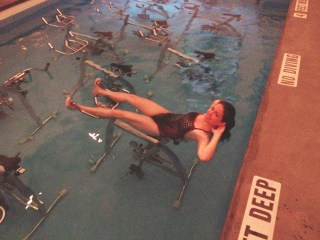
If you’re looking to revamp your workout, just add water. Trust us, your body will feel the difference.
In Europe, “aqua cycling” is already making a splash, and the trend is coming stateside, with the first underwater cycling studio that recently opened in New York City.
I’ve attempted my fair share of hybrid workouts — from the so-called “Pilates on crack” class to trampoline aerobics — but underwater biking is an entirely novel fitness fad, at least in the U.S.
And this is no aqua-aerobics. Originally used as physical therapy for injured athletes, underwater stationary bikes are going mainstream. Former fashion photography producer and French expat Esther Gauthier opened Aqua Studio in New York last month for anyone eager to try something just a little different. It’s your standard cycling class, with all the rows of stationary bikes, upbeat music and peppy trainers, and submerge the whole set-up in 4-feet of water, and you get the idea.
(MORE: We Tried This: With MovNat, Play Like You’re a Kid Again)
“I was visiting my family in Paris two years ago, and I took my first aqua biking class. It was the first time I had even heard about it, and I was so surprised. It is very rare that [a fitness trend] is not in the U.S.,” says Gauthier. “I followed the evolution of the trend and I decided to bring the concept here. It started in Italy as a physical therapy, and it became so popular when it was transitioned into a class instead of just one individual in a pool with a bike. It really started to spread in Spain, Portugal and then France.”
There are several aqua bike manufactures — all of which are located in Europe, and all of whom are claiming to be the first to pioneer the underwater bike. (Gauthier orders hers from Italian bike maker, Hydrorider.)
(MORE: We Tried This: “Pop-Up” Cardio)
As I’ve said, aqua cycling is not your grandma’s water aerobics, although I admit to being schooled by an older woman pushing 70 on the bike next to me. Instead of a control knob that makes pedaling more challenging, riders simply pump faster and let the water provide more resistance. The natural massage from the water pressure also reaches the deeper muscles that are tougher to stimulate on land.
“On land, you’re not getting the same resistance. The massage you’re getting from the water hits the region of the leg where the fats accumulate on the muscle. It helps drain the lymphatic system and eliminates more calories and toxins, and burns more cellulite than on land,” explains Gauthier. Depending on your body type, bikers can burn up to 800 calories over an hour of aqua cycling.
(MORE: We Tried This: Body-Busting Barre)
You can’t tell how much you’re sweating when you’re in the water, so despite my struggling and panting, I think (I hope) I kept my cool. During the few minutes of recovery between intervals, the swooshing water is quite relaxing and was almost enough to make me nod off (which didn’t please the instructor — but I’ll blame the 7 a.m. class time).
The water also allows for more nimble movements around the bike, which really sets it apart from the average cycling session. At one point, I was told to keep my feet strapped into the pedals, but position my body behind the bike, and let go. If it’s hard to imagine how someone stays afloat in such a contortion, let me tell you, it’s even harder to pull off. The position forced us to tread water — or frantically try to stay afloat, in my case. It was tough, but it work out the arms, legs and abs.
In another position, we strapped our feet underneath the handle bars, lay across the seat, and cranked out sets of crunches.
(MORE: We Tried This: ‘Shockwave’ Rowing Workout)
My fellow aqua-spinners were a diverse group, with a mix of beginners and gym gurus of all ages (including the previously mentioned 70+ year-old), which attests to its wide appeal. But everyone had similar goals — to get a good workout and stay injury-free. The water supports your body weight, which relieves pressure on the joints., making it popular among people recovering from injuries, as well as overweight individuals who want to exercise without straining joints.
The class can be a good antidote to the hazards that other, or excessive workouts, can cause, says Gauthier. It was, after all, developed initially to help people recover from injuries. “The problem, especially in New York, is that people are addicted to working out,” she says. “It is good for your health to have physical activity, but if it’s too much, and too repetitive, and done the wrong way, eventually you create injuries. Since we opened, we have seen so many women come in with injuries, but they are often really young and have just been working out a lot with boot camps and cycling classes that are really intense.” Gauthier says that within the first month of opening, she and her trainers have seen a significant number of customers asking for a hard cardio workout without the added strain that other programs can cause.
While Aqua Studio is the only aqua cycling gym in the U.S., it isn’t likely to retain that status for long. Currently, Gauthier’s small studio only has classes for women (primarily because she only had the women’s locker room ready before opening), but given the high number of requests from men, she’s considering adding more co-ed classes soon.


